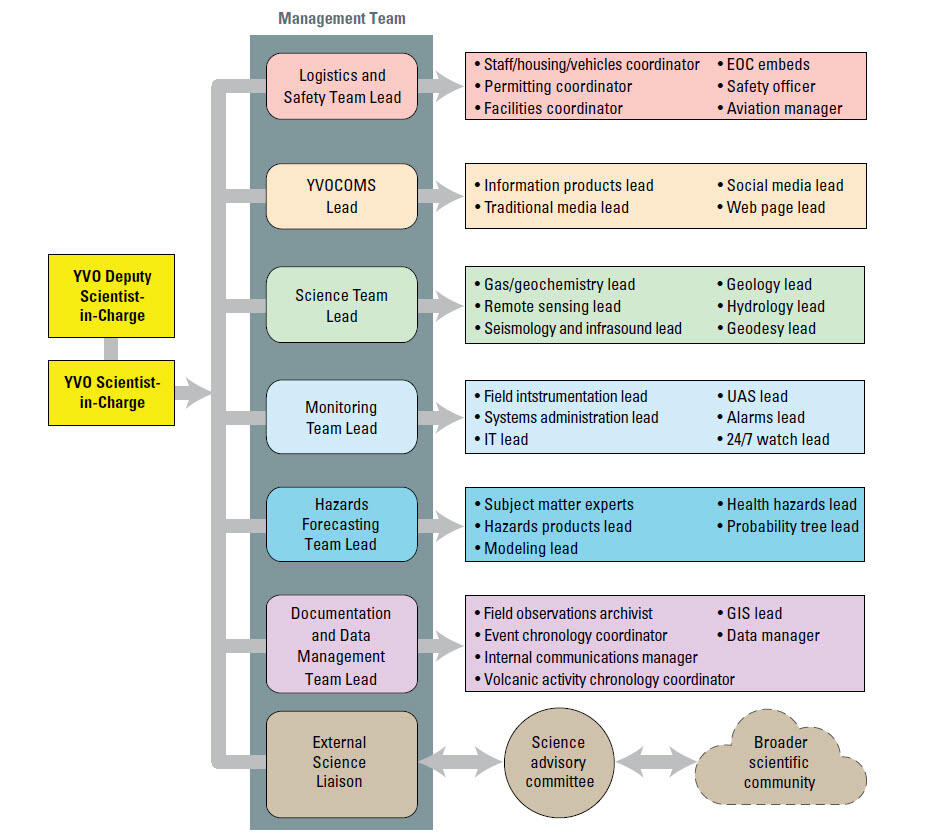YVO’s plan for responding to future geological hazards in Yellowstone National Park
YVO just released an updated version of its response plan for geological hazards in Yellowstone National Park. The plan describes how Yellowstone Volcano Observatory scientists will monitor and communicate information about any future hydrothermal, seismic, and volcanic activity.
Yellowstone Caldera Chronicles is a weekly column written by scientists and collaborators of the Yellowstone Volcano Observatory. This week's contribution is from Michael Poland, geophysicist with the U.S. Geological Survey and Scientist-in-Charge of the Yellowstone Volcano Observatory.
As Benjamin Franklin supposedly said, “failing to plan is planning to fail.” This is why the Yellowstone Volcano Observatory (YVO) has a plan to guide the observatory’s actions during a response to earthquakes, hydrothermal explosions, or any geological activity that could lead to a volcanic eruption.
The first YVO response plan was published in 2010 and explained how observatory scientists would collect data, communicate with one another and the public, and interact with emergency managers as part of any incident command system that was organized to deal with a crisis—for example, a major earthquake or volcanic eruption.
A second version of the YVO response plan was published in 2014 and incorporated changes in the YVO consortium, which expanded in 2013 to include more institutions, as well as lessons learned from a readiness, or “table-top,” exercise that was held in 2011. Table-top exercises are discussions that simulate a crisis and that are used by emergency responders to practice and evaluate procedures.
The newest version of the YVO response plan was just published (https://pubs.usgs.gov/circ/1351/). This update contains several significant modifications compared to the previous versions.
First and foremost, the YVO response plan now aligns with a procedures established by the USGS Volcano Science Center—particularly the “OVERT,” or Observatory Volcano Event Response Team, concept. OVERT defines critical functions, like data management, communications, monitoring, science, and logistical support, that can be staffed up during a crisis. The OVERT team can be implemented in stages to follow the nature of whatever volcanic unrest or eruption may be unfolding and is intended to be flexible and modular. The concept also establishes clear lines of communication and reporting so that no one person has too many responsibilities, and information is shared quickly and openly.
As an example, if a major seismic swarm were to begin in Yellowstone National Park, YVO might establish an OVERT organizational structure that has staffing for the monitoring and communications teams. If that seismicity intensified and led to hydrothermal explosions, those teams would be expanded to take on additional responsibilities, and other branches would also be staffed—like those dealing with data documentation and logistics to support field operations.
YVO’s updated response plan also defines two different cases: “events” and “activity with potential.” An “event” is a single and sudden hazardous occurrence, like the 1959 M7.3 Hebgen Lake earthquake or the July 23, 2024, hydrothermal explosion at Biscuit Basin, that would prompt YVO to immediately initiate additional monitoring and to communicate hazards information to emergency managers and the public. Because some geologic hazards evolve slowly, however, YVO’s response plan also defines “activity with potential” that could eventually build towards a hazard that requires intense monitoring. The 2003 thermal event at Norris Geyser Basin, when ground heated to boiling temperatures in places and caused some boardwalks to be closed and eventually rerouted, is a good example.
Also included in the response plan are communications protocols and call-down lists that establish robust methods for ensuring that information is passed along to emergency managers at various institutions, like the area land managers and, in the event of an explosive volcanic eruption, the Federal Aviation Administration and National Weather Service. Additional guidelines describe how YVO consortium members would collaborate to ensure that the public—especially local residents—are informed of hazards that may develop, and steps that can be taken to lessen the impacts of those hazards.
By developing this response plan, and also putting it into practice—for instance, as part of a table-top exercise that was held for YVO consortium members in 2022—YVO scientists will be better prepared to deal with any future geologic hazards in the Yellowstone region. Hopefully there will never need to be put the YVO response protocols into practice in response to a serious geologic hazard. But we must not fail to plan.




